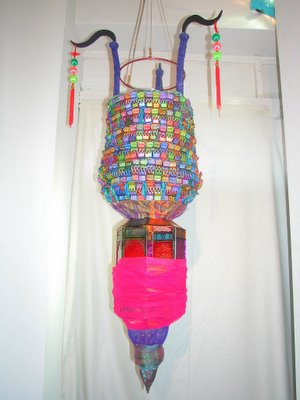
The following review by D. Dominick Lombardi of Gae Savannah's exhibition at Dam Stuhltrager was published in the September 2006 issue of Sculpture Magazine.
Gae Savannah’s art is precious. It links to a trait that we all seem to have, especially in this day and age—the desire to find treasure. In looking at Savannah’s work, I am reminded of an experience that recently sprang to mind when my 10-year daughter showed me a rock with shiny little flecks of mica and announced with great glee, “Dad, I found gold!” I was transported to my own youth, to the moment when I had found an eerily similar rock and asked my father if I had found gold.
It took a while before I gave up on that rock—and the chance I might stumble upon something of great value has never left me. I relay this story because it relates directly to what I see in Savannah’s works, which have a reverence for the common object, funneled, in this case, through cultural reference and manipulated scale. The cultural reference is easy to see. Just look at Nhanshhe or Niu Kua and you will find distinct Asian properties such as architectural lines, fabric types, and meditative forms. Savannah also tests the viewer’s ability to place these works in time since many eras are loosely referenced.
Her most effective skill is to control scale by massing many examples of a familiar object, such as candy-colored beads and hair clips, into compelling forms and structures. The best example is Laika—an intriguing work made up of an elevated, ceremonial-looking enclosure that has extensive reach of influence by way of ritual procession and regal elevation. The hierarchy here projects a substantive reorientation of form and function based on flexible beliefs and universal appeal.
Works such as Shasta and Nyassa are the most confounding and difficult to read. They subtly suggest the aforementioned visual traits, but they seem more secretive and guarded in their meaning. In fact, Shasta, which is mostly veiled and lit from within, looks more like a stained glass obelisk than any functional structure. Nyassa tends more toward abstraction, even Modernism, by balancing texture, line, form, and color equally. The four segments in Nyassa, for me, create a tension that is hard to make peace with because it has no central focus. Perhaps Savannah is adding a bit of defiance to keep us on our toes.
Kisu, Paroxysm, and Satresine lean more toward the decorative, having a less ritualistic feel. However, they still maintain an appeal because they challenge preconceived notions relative to form and function. I suspect that curator David Gibson had this is mind when you factor in the oddly framed layout of the cigar-store-type gallery space.
Whatever reasons Savannah has for making these works, they achieve two important feats. Her sculptures will forever change the way we look at the connections between ornamentation and function, just as they remind us of how the most common objects have the potential to become treasures.
It took a while before I gave up on that rock—and the chance I might stumble upon something of great value has never left me. I relay this story because it relates directly to what I see in Savannah’s works, which have a reverence for the common object, funneled, in this case, through cultural reference and manipulated scale. The cultural reference is easy to see. Just look at Nhanshhe or Niu Kua and you will find distinct Asian properties such as architectural lines, fabric types, and meditative forms. Savannah also tests the viewer’s ability to place these works in time since many eras are loosely referenced.
Her most effective skill is to control scale by massing many examples of a familiar object, such as candy-colored beads and hair clips, into compelling forms and structures. The best example is Laika—an intriguing work made up of an elevated, ceremonial-looking enclosure that has extensive reach of influence by way of ritual procession and regal elevation. The hierarchy here projects a substantive reorientation of form and function based on flexible beliefs and universal appeal.
Works such as Shasta and Nyassa are the most confounding and difficult to read. They subtly suggest the aforementioned visual traits, but they seem more secretive and guarded in their meaning. In fact, Shasta, which is mostly veiled and lit from within, looks more like a stained glass obelisk than any functional structure. Nyassa tends more toward abstraction, even Modernism, by balancing texture, line, form, and color equally. The four segments in Nyassa, for me, create a tension that is hard to make peace with because it has no central focus. Perhaps Savannah is adding a bit of defiance to keep us on our toes.
Kisu, Paroxysm, and Satresine lean more toward the decorative, having a less ritualistic feel. However, they still maintain an appeal because they challenge preconceived notions relative to form and function. I suspect that curator David Gibson had this is mind when you factor in the oddly framed layout of the cigar-store-type gallery space.
Whatever reasons Savannah has for making these works, they achieve two important feats. Her sculptures will forever change the way we look at the connections between ornamentation and function, just as they remind us of how the most common objects have the potential to become treasures.
Comments